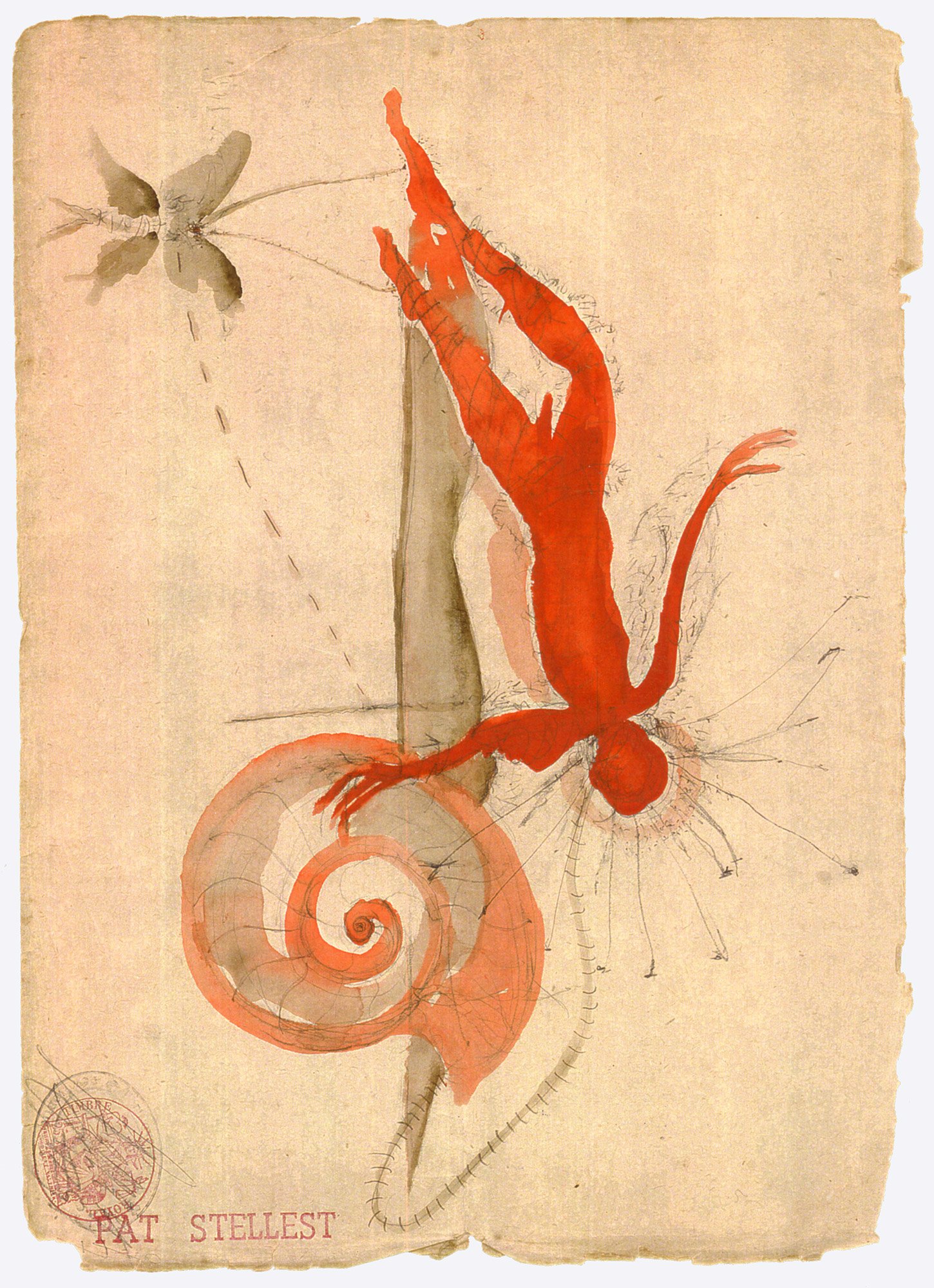A few thousand drawings and paintings later, it is certainly difficult to look back on a rich career. I have chosen to present here a handful of the most representative works from my various creative periods.
Cosmic Cobalt Wind Horse with Messenger of Peace
In Cosmic Cobalt Wind Horse with Messenger of Peace, Patrice Stellest transports us into a dreamlike and mystical universe, where symbolism and visual beauty intertwine to create a deeply evocative work. This painting, imbued with a cosmic atmosphere, depicts a majestic horse, the “Wind Horse,” in cobalt hues, accompanied by an ethereal figure, the “Messenger of Peace.”
The horse, with its translucent and shimmering body, seems to glide through infinite space, its mane and tail flowing in fluid shapes reminiscent of waves. Its appearance is marked by organic patterns and shades of blue and violet, evoking currents of cosmic energy. The horse embodies freedom and power, while its cobalt color symbolizes the mystery and unknown of the universe.
The accompanying figure, the “Messenger of Peace,” is depicted in an airborne posture, arms extended forward as if offering or receiving something invisible. The stylized body, outlined by fluid lines, seems to merge with the horse, creating an image of unity and symbiosis. This dark figure, in contrast with the luminous horse, carries a message of peace, an appeal for harmony and balance in the vast cosmos.
The background is scattered with celestial motifs, including stars and planets, adding to the mystical and transcendental ambiance. The color palette, dominated by shades of blue, black, and violet, creates a serene and contemplative atmosphere, accentuated by soft light that illuminates the contours of the characters.
The elements of the composition are connected by delicate ribbons and curves, symbolizing the incessant flow of energy and movement in the universe. These fluid lines bring dynamism to the work, reinforcing the idea of journey and transformation.
Cosmic Cobalt Wind Horse with Messenger of Peace is a poetic exploration of the spiritual journey and the quest for inner peace. Stellest uses the symbols of the horse and the messenger to represent universal themes of freedom, wisdom, and reconciliation. Through this work, the artist invites the viewer to reflect on the role of peace in our world and how we can all contribute to a harmonious cosmic balance.
The horse, with its translucent and shimmering body, seems to glide through infinite space, its mane and tail flowing in fluid shapes reminiscent of waves. Its appearance is marked by organic patterns and shades of blue and violet, evoking currents of cosmic energy. The horse embodies freedom and power, while its cobalt color symbolizes the mystery and unknown of the universe.
The accompanying figure, the “Messenger of Peace,” is depicted in an airborne posture, arms extended forward as if offering or receiving something invisible. The stylized body, outlined by fluid lines, seems to merge with the horse, creating an image of unity and symbiosis. This dark figure, in contrast with the luminous horse, carries a message of peace, an appeal for harmony and balance in the vast cosmos.
The background is scattered with celestial motifs, including stars and planets, adding to the mystical and transcendental ambiance. The color palette, dominated by shades of blue, black, and violet, creates a serene and contemplative atmosphere, accentuated by soft light that illuminates the contours of the characters.
The elements of the composition are connected by delicate ribbons and curves, symbolizing the incessant flow of energy and movement in the universe. These fluid lines bring dynamism to the work, reinforcing the idea of journey and transformation.
Cosmic Cobalt Wind Horse with Messenger of Peace is a poetic exploration of the spiritual journey and the quest for inner peace. Stellest uses the symbols of the horse and the messenger to represent universal themes of freedom, wisdom, and reconciliation. Through this work, the artist invites the viewer to reflect on the role of peace in our world and how we can all contribute to a harmonious cosmic balance.
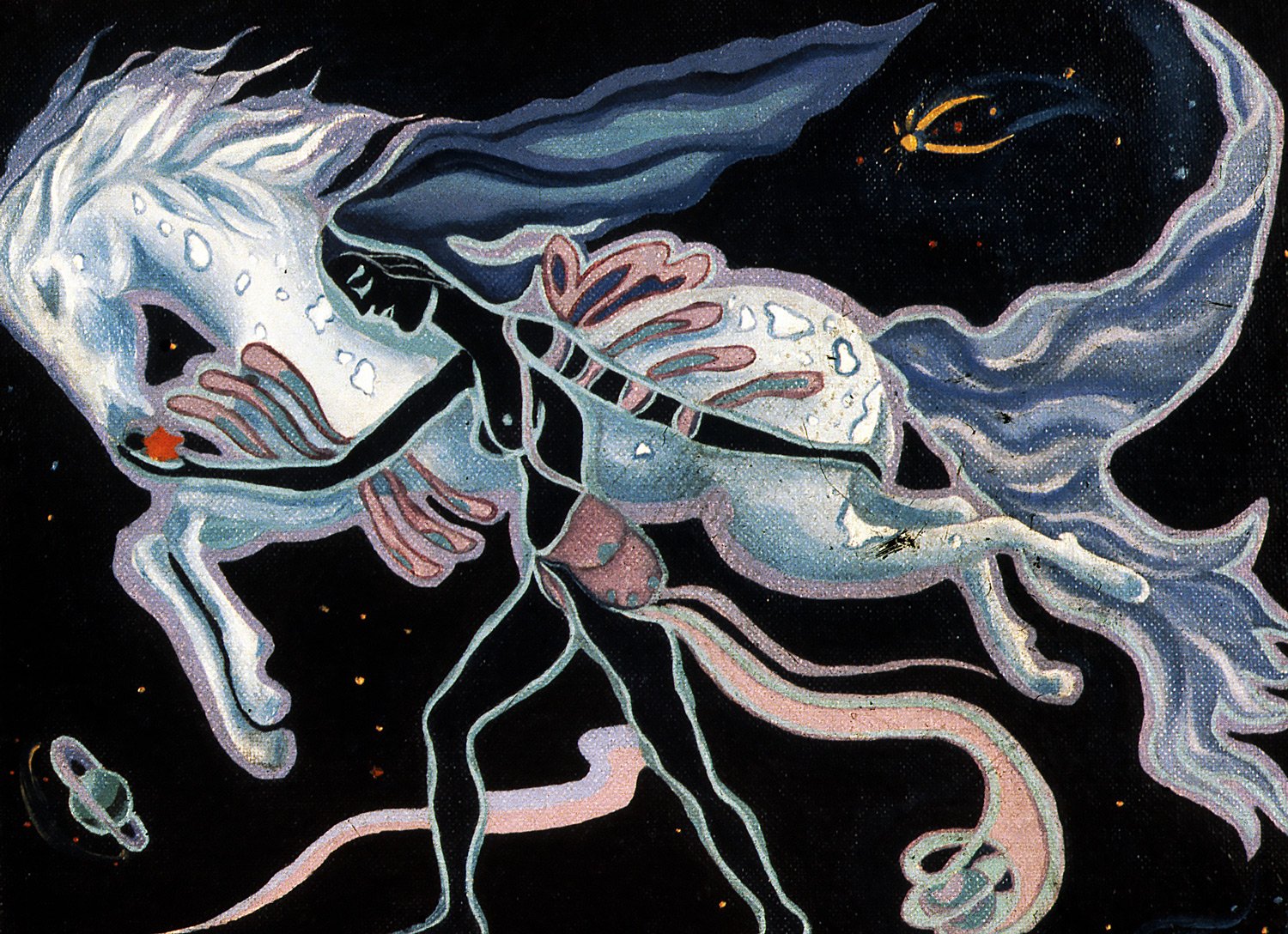
The Sower of Artenay
In The Sower of Artenay, Patrice Stellest offers a captivating and allegorical vision rooted in the small commune of Artenay in France, where the artist once lived. This work explores the figure of the sower, a traditional symbol of fertility and renewal, and gives it a futuristic and critical dimension. The painting juxtaposes the ancestral act of sowing with a reflection on humanity’s impact on nature.
The central figure, the sower, is depicted in a dynamic pose, casting seeds with a wide, generous gesture. He is dressed in a stylized outfit, with geometric and angular shapes suggesting a fusion between man and machine, evoking a futuristic aesthetic. The metallic tones and shimmering reflections on his costume accentuate the impression of a being that is both human and technological.
The sower wears a wide hat that seems to float above his head, adding a touch of mystery and majesty to his silhouette. His face, partially obscured by shadow, conveys an expression of concentration and gravity. The composition is dominated by warm colors, with an earthy brown background that recalls the soil of Artenay and the deep connection between man and the land.
A crucial element in this work is a seed marked with a red stripe, symbolizing a dark and critical vision of the future. This corrupted seed, different from the others, represents the threat of genetic manipulation and human contamination. It serves as a warning about the potential dangers of human intervention in natural processes, evoking ecological and ethical concerns.
The lines and shapes are fluid and dynamic, creating a sense of continuous movement. The golden light emanating from the sower’s hand and the seeds seems to radiate, symbolizing the power of life and the potential within each seed. However, the presence of the red seed introduces a dissonant note, reminding us that the act of sowing, once a symbol of hope and renewal, can now be tainted by human error and abuse.
The Sower of Artenay is thus a poetic and critical reflection on the intersection of tradition and modernity, nature and technology. Through this work, Stellest questions the viewer about human responsibility towards the earth and the consequences of our collective choices. It is a celebration of nature and a call for vigilance and contemplation regarding our role in shaping the future.
The central figure, the sower, is depicted in a dynamic pose, casting seeds with a wide, generous gesture. He is dressed in a stylized outfit, with geometric and angular shapes suggesting a fusion between man and machine, evoking a futuristic aesthetic. The metallic tones and shimmering reflections on his costume accentuate the impression of a being that is both human and technological.
The sower wears a wide hat that seems to float above his head, adding a touch of mystery and majesty to his silhouette. His face, partially obscured by shadow, conveys an expression of concentration and gravity. The composition is dominated by warm colors, with an earthy brown background that recalls the soil of Artenay and the deep connection between man and the land.
A crucial element in this work is a seed marked with a red stripe, symbolizing a dark and critical vision of the future. This corrupted seed, different from the others, represents the threat of genetic manipulation and human contamination. It serves as a warning about the potential dangers of human intervention in natural processes, evoking ecological and ethical concerns.
The lines and shapes are fluid and dynamic, creating a sense of continuous movement. The golden light emanating from the sower’s hand and the seeds seems to radiate, symbolizing the power of life and the potential within each seed. However, the presence of the red seed introduces a dissonant note, reminding us that the act of sowing, once a symbol of hope and renewal, can now be tainted by human error and abuse.
The Sower of Artenay is thus a poetic and critical reflection on the intersection of tradition and modernity, nature and technology. Through this work, Stellest questions the viewer about human responsibility towards the earth and the consequences of our collective choices. It is a celebration of nature and a call for vigilance and contemplation regarding our role in shaping the future.
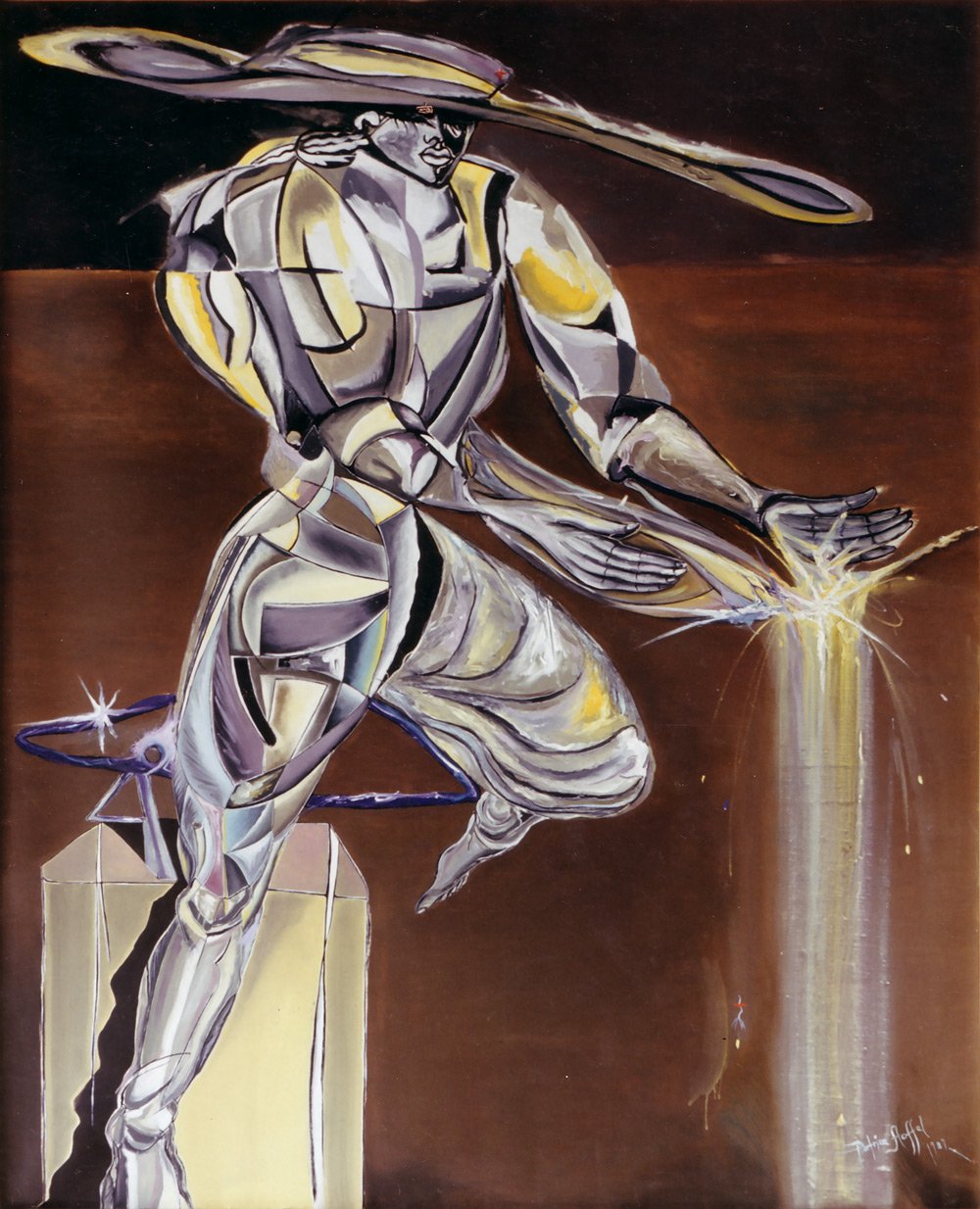
Cosmic Leda
In Cosmic Leda, Patrice Stellest reinterprets the mythological figure of Leda, mother of the famous Castor and Pollux, as well as the beautiful Helen of Troy. This surreal and expressive painting blends classical elements with a contemporary vision, exploring the duality between the human and the divine, the universal and the intimate.
The central figure, representing Leda, is surrounded by fluid and dynamic forms, creating a composition that evokes the perpetual movement of the universe. Her face is delicately sculpted, with expressive and slightly asymmetrical features, suggesting both the beauty and complexity of her mythological existence. Her captivating eyes, highlighted by long, fine eyelashes, seem to pierce the veil of reality to contemplate infinity.
The dominant colors in the work oscillate between shades of blue, gray, and violet, creating an ethereal atmosphere that evokes the cosmos. Bursts of yellow and white light subtly illuminate certain elements, accentuating the sacred and transcendental character of the scene. The softly diffused light seems to emanate from the figure herself, symbolizing her divine and mystical nature.
The curved and enveloping lines surrounding Leda can be interpreted as symbols of protection or cosmic energy. These abstract forms create a sense of depth and movement, inviting the viewer to a visual and spiritual exploration. The overall composition, with its blurred contours and harmonious color transitions, creates an impression of a waking dream, where the viewer is invited to meditate on the mysteries of existence.
Cosmic Leda is a celebration of femininity and creative power. By associating Greek mythology with a modern and cosmic aesthetic, Stellest transcends eras and cultures, offering a unique vision of unity between the human and the divine. This work embodies a quest for understanding and connection with the greater whole, where every detail invites profound and poetic contemplation.
The central figure, representing Leda, is surrounded by fluid and dynamic forms, creating a composition that evokes the perpetual movement of the universe. Her face is delicately sculpted, with expressive and slightly asymmetrical features, suggesting both the beauty and complexity of her mythological existence. Her captivating eyes, highlighted by long, fine eyelashes, seem to pierce the veil of reality to contemplate infinity.
The dominant colors in the work oscillate between shades of blue, gray, and violet, creating an ethereal atmosphere that evokes the cosmos. Bursts of yellow and white light subtly illuminate certain elements, accentuating the sacred and transcendental character of the scene. The softly diffused light seems to emanate from the figure herself, symbolizing her divine and mystical nature.
The curved and enveloping lines surrounding Leda can be interpreted as symbols of protection or cosmic energy. These abstract forms create a sense of depth and movement, inviting the viewer to a visual and spiritual exploration. The overall composition, with its blurred contours and harmonious color transitions, creates an impression of a waking dream, where the viewer is invited to meditate on the mysteries of existence.
Cosmic Leda is a celebration of femininity and creative power. By associating Greek mythology with a modern and cosmic aesthetic, Stellest transcends eras and cultures, offering a unique vision of unity between the human and the divine. This work embodies a quest for understanding and connection with the greater whole, where every detail invites profound and poetic contemplation.
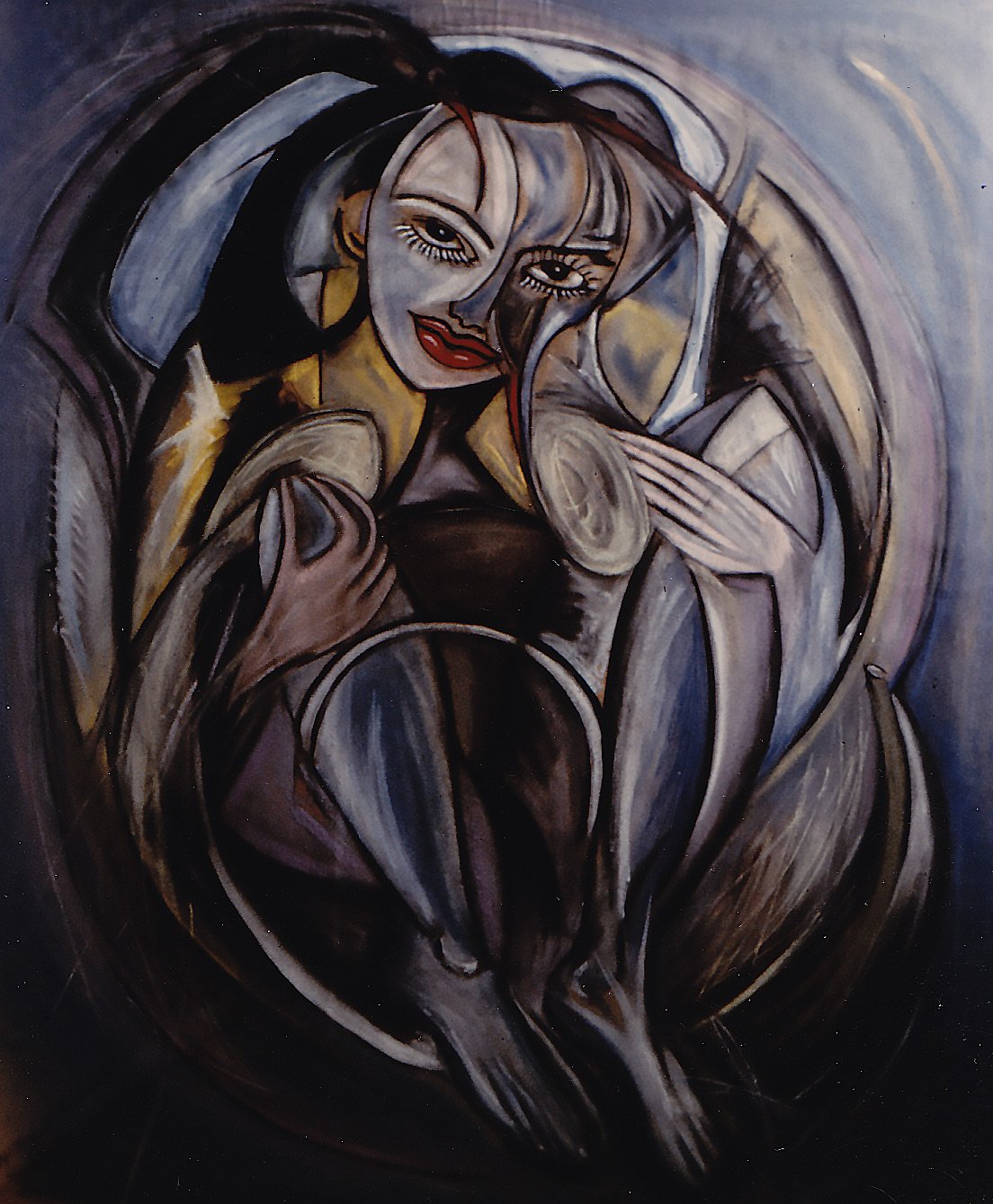
The Hug
The Hug, a captivating work by Patrice Stellest, embodies intimacy and human connection through a vibrant and stylized composition. This painting, which seems to dance on the canvas, depicts two abstract figures fused in an embrace. The characters, represented in an unconventional manner, are enveloped in a symphony of lines and colors, creating an atmosphere that is both dynamic and serene.
The figure on the left, painted in black with subtle touches of bright colors, contrasts sharply with the figure on the right, which is lighter, almost diaphanous, with pastel shades. This visual dichotomy may symbolize the complementarity of opposites or the union of two distinct forces. Their faces are simplified, without detailed features, which universalizes their embrace and allows viewers to project their own emotions and stories onto the work.
The contours of the bodies are fluid and graceful, reminiscent of the movement of water or organic curves. The lines that surround and traverse them create a sense of movement and energy, evoking the idea that love and affection transcend the static. These lines are not merely contours; they are vectors of emotion, guiding the eye across the canvas and telling a story of deep connection.
The background is composed of warm tones mixed with blues and reds, suggesting an atmosphere that is both intimate and vast. The shades blend harmoniously, creating an enveloping ambiance that accentuates the central theme of the embrace. There is a subtlety in the use of light and shadow, adding depth and mystery to the whole.
The Hug is an exploration of human intimacy, capturing a moment of tenderness and connection. Through this work, Stellest invites us to reflect on the forces that unite us despite our differences. It is a celebration of universal love and mutual understanding, where each line and color contributes to a visual symphony rich in meaning and emotion.
The figure on the left, painted in black with subtle touches of bright colors, contrasts sharply with the figure on the right, which is lighter, almost diaphanous, with pastel shades. This visual dichotomy may symbolize the complementarity of opposites or the union of two distinct forces. Their faces are simplified, without detailed features, which universalizes their embrace and allows viewers to project their own emotions and stories onto the work.
The contours of the bodies are fluid and graceful, reminiscent of the movement of water or organic curves. The lines that surround and traverse them create a sense of movement and energy, evoking the idea that love and affection transcend the static. These lines are not merely contours; they are vectors of emotion, guiding the eye across the canvas and telling a story of deep connection.
The background is composed of warm tones mixed with blues and reds, suggesting an atmosphere that is both intimate and vast. The shades blend harmoniously, creating an enveloping ambiance that accentuates the central theme of the embrace. There is a subtlety in the use of light and shadow, adding depth and mystery to the whole.
The Hug is an exploration of human intimacy, capturing a moment of tenderness and connection. Through this work, Stellest invites us to reflect on the forces that unite us despite our differences. It is a celebration of universal love and mutual understanding, where each line and color contributes to a visual symphony rich in meaning and emotion.
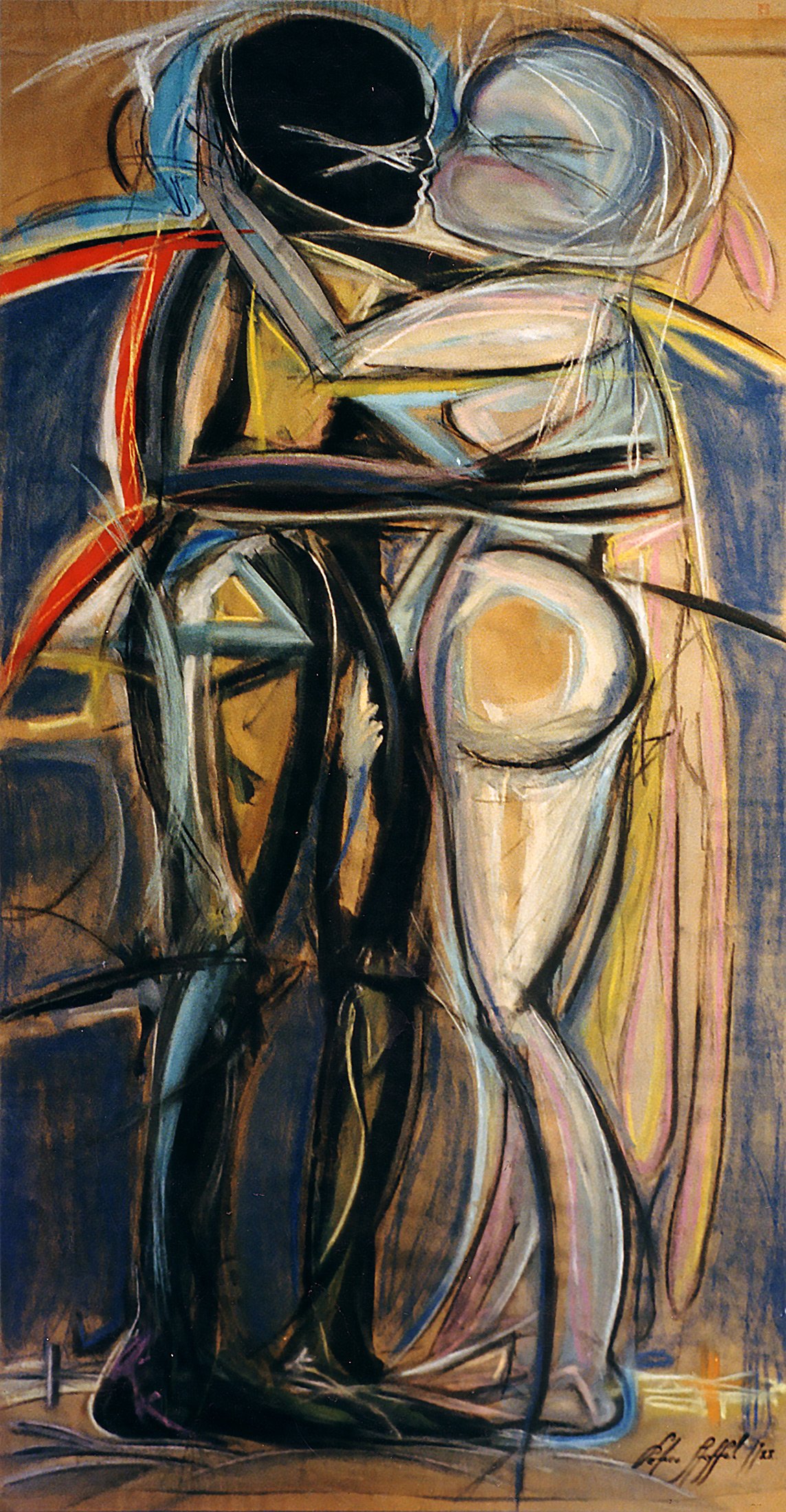
Cosmic Don Quixote
The work Cosmic Don Quixote by Patrice Stellest presents itself as a visual dialogue between history and contemporaneity, where the past and present meet in a dance of shapes and symbols.
Painted on royal documents dating from before the French Revolution, the work immediately establishes a tension between the fragility of history and the vitality of contemporary artistic expression. These parchments, silent witnesses to a bygone era, become here the backdrop for a cosmic and timeless exploration embodied by the figure of Don Quixote. The choice of these documents is not trivial: they evoke nobility, ideals, and the dreams of an old world, while emphasizing the persistence of these concepts through the lens of modern art.
Stellest offers us a dematerialized Don Quixote, transcending the limits of simple representation to become a cosmic entity. The features are fluid, evoking perpetual motion, an endless quest through stars and galaxies. The circles and geometric shapes that punctuate the work recall planetary orbits, the eternal cycles of life and the cosmos, suggesting a quest that is not only terrestrial but also universal.
The colors, though subtle, reinforce this cosmic dimension. The bluish and silver tones evoke interstellar cold, while touches of red draw the eye, like bursts of energy or beacons in the infinity of space. These graphic elements, inscribed in the composition, interact with the ancient letters and words, creating an interplay between visual and textual language.
Stellest’s interpretation of Don Quixote goes beyond simple chivalric folly. Here, the character becomes a metaphor for humanity itself, in a perpetual quest for meaning in a vast and often incomprehensible universe. The lines that traverse the work, sometimes straight, sometimes curved, symbolize both the obstacles and the paths taken in this existential quest.
The choice to paint on royal documents adds a layer of meaning: it is a reappropriation of history, where the artist reinvents the past to better question the present and the future. These documents, once symbols of authority and power, are here desacralized, transformed into a medium for a deeper reflection on the human condition.
In sum, Cosmic Don Quixote by Patrice Stellest is a work that questions, fascinates, and transports the viewer. It succeeds in marrying tradition and modernity, history and myth, to create a new and bold vision of humanity’s eternal quest in the face of infinity.
Painted on royal documents dating from before the French Revolution, the work immediately establishes a tension between the fragility of history and the vitality of contemporary artistic expression. These parchments, silent witnesses to a bygone era, become here the backdrop for a cosmic and timeless exploration embodied by the figure of Don Quixote. The choice of these documents is not trivial: they evoke nobility, ideals, and the dreams of an old world, while emphasizing the persistence of these concepts through the lens of modern art.
Stellest offers us a dematerialized Don Quixote, transcending the limits of simple representation to become a cosmic entity. The features are fluid, evoking perpetual motion, an endless quest through stars and galaxies. The circles and geometric shapes that punctuate the work recall planetary orbits, the eternal cycles of life and the cosmos, suggesting a quest that is not only terrestrial but also universal.
The colors, though subtle, reinforce this cosmic dimension. The bluish and silver tones evoke interstellar cold, while touches of red draw the eye, like bursts of energy or beacons in the infinity of space. These graphic elements, inscribed in the composition, interact with the ancient letters and words, creating an interplay between visual and textual language.
Stellest’s interpretation of Don Quixote goes beyond simple chivalric folly. Here, the character becomes a metaphor for humanity itself, in a perpetual quest for meaning in a vast and often incomprehensible universe. The lines that traverse the work, sometimes straight, sometimes curved, symbolize both the obstacles and the paths taken in this existential quest.
The choice to paint on royal documents adds a layer of meaning: it is a reappropriation of history, where the artist reinvents the past to better question the present and the future. These documents, once symbols of authority and power, are here desacralized, transformed into a medium for a deeper reflection on the human condition.
In sum, Cosmic Don Quixote by Patrice Stellest is a work that questions, fascinates, and transports the viewer. It succeeds in marrying tradition and modernity, history and myth, to create a new and bold vision of humanity’s eternal quest in the face of infinity.
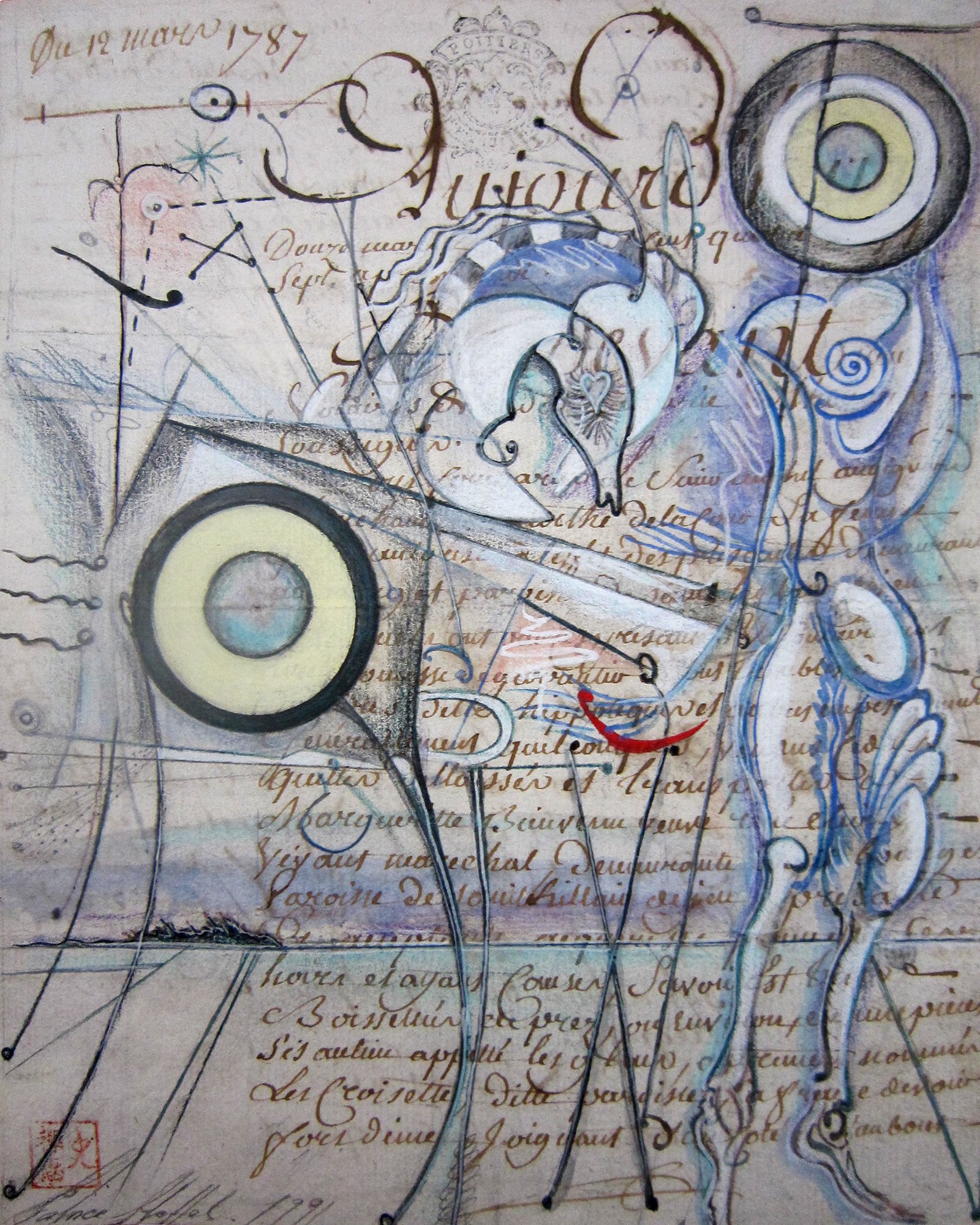
Sleeping Woman
In Sleeping Woman, Patrice Stellest merges the timelessness of art with the depth of history by using royal notarial deeds from before the French Revolution as the canvas. This work, imbued with serenity and mystery, features a reclining female figure, immersed in a peaceful sleep. The contrast between the softness of the scene and the historical background gives the work a meditative and poetic dimension.
The woman, depicted with fluid contours and earthy tones, seems to blend into the textual background of the work. Her delicately curved body is partially draped, revealing a discreet and natural sensuality. Her pose, tranquil and abandoned, evokes a moment of complete relaxation, where time seems suspended. The color palette, dominated by warm and soft hues, adds to the atmosphere of calm emanating from the composition.
The support chosen by Stellest, these old documents with elegant handwritten scripts and faded inks, brings an additional depth to the work. The words and phrases, almost illegible in places, evoke a distant and mysterious past. They remind us of a bygone era, marked by traditions and institutions that shaped history. The juxtaposition of contemporary imagery with historical texts creates a tension between the past and present, inviting the viewer to reflect on permanence and change.
A notable element of the work is the presence of a small animal, possibly a dog or a lamb, situated at the woman’s feet. This creature, painted with particular attention to detail, seems to watch over the sleeper, adding a touch of tenderness and protection to the scene. The gaze of the animal, turned towards the woman, creates a subtle link between the two figures, reinforcing the idea of connection and safety.
Sleeping Woman is a work that questions the relationship between personal intimacy and the weight of collective history. By using royal notarial deeds as a support, Stellest anchors his creation in a specific historical context while exploring universal themes such as tranquility, dreams, and memory. This painting, both delicate and profound, invites contemplation of the passage of time and the stories we carry within us, consciously or not. It is an ode to the beauty of ephemeral moments and the richness of narratives embedded in our cultural heritage.
The woman, depicted with fluid contours and earthy tones, seems to blend into the textual background of the work. Her delicately curved body is partially draped, revealing a discreet and natural sensuality. Her pose, tranquil and abandoned, evokes a moment of complete relaxation, where time seems suspended. The color palette, dominated by warm and soft hues, adds to the atmosphere of calm emanating from the composition.
The support chosen by Stellest, these old documents with elegant handwritten scripts and faded inks, brings an additional depth to the work. The words and phrases, almost illegible in places, evoke a distant and mysterious past. They remind us of a bygone era, marked by traditions and institutions that shaped history. The juxtaposition of contemporary imagery with historical texts creates a tension between the past and present, inviting the viewer to reflect on permanence and change.
A notable element of the work is the presence of a small animal, possibly a dog or a lamb, situated at the woman’s feet. This creature, painted with particular attention to detail, seems to watch over the sleeper, adding a touch of tenderness and protection to the scene. The gaze of the animal, turned towards the woman, creates a subtle link between the two figures, reinforcing the idea of connection and safety.
Sleeping Woman is a work that questions the relationship between personal intimacy and the weight of collective history. By using royal notarial deeds as a support, Stellest anchors his creation in a specific historical context while exploring universal themes such as tranquility, dreams, and memory. This painting, both delicate and profound, invites contemplation of the passage of time and the stories we carry within us, consciously or not. It is an ode to the beauty of ephemeral moments and the richness of narratives embedded in our cultural heritage.
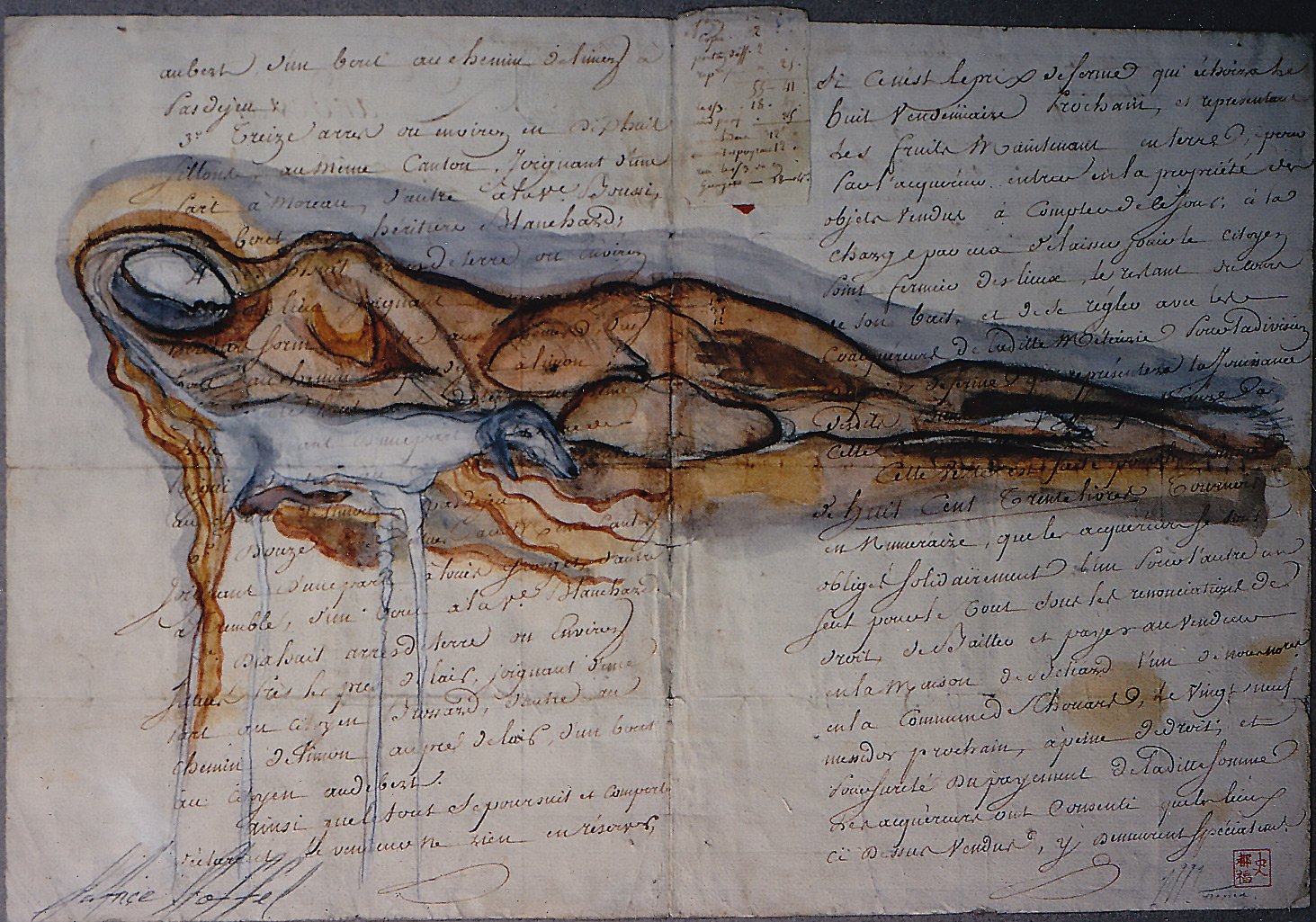
Princess Sleeping in a Lotus Flower
In the work Princess Sleeping in a Lotus Flower, Patrice Stellest immortalizes a suspended moment, a scene of serene and mysterious beauty, painted for Princess Caroline of Monaco.
Here, a female figure, lying in the deep calm of sleep, nestles in the delicate embrace of lotus petals, a sacred flower symbolizing purity and rebirth. Through fluid and ethereal contours, Stellest depicts a princess in harmony with the natural world, immersed in a silent dream, as if protected by the very arms of nature.
The graceful lines that shape her body subtly blend with the petals of the lotus, creating an almost mystical unity between the human and the natural. Each brushstroke seems to breathe gentleness and tranquility, while the princess’s floating posture evokes a state of deep meditation, a refuge far from the tumult of everyday life. The lotus, in its protective majesty, becomes both cradle and sanctuary, embodying eternal serenity.
In the background, barely sketched, another symbol emerges: that of the elephant. Faithful to her particular attachment to Africa, Princess Caroline finds an echo here, drawn with elegant simplicity, recalling her love for the continent. This connection with Africa resonates with Stellest’s commitment, whose installation Stellephant bears witness to his artistic fight for the protection of elephants.
Thus, through this discreet detail, the work subtly dialogues with the engaged universes of both figures, Caroline and Stellest, united in their defense of the majestic beings that are elephants, symbols of wisdom and memory.
The background remains discreet, leaving all the necessary space for this union between the princess and the flower, and the delicate addition of the elephant enhances the spiritual and engaged dimension of the work. Stellest’s soft and soothing palette evokes a world where inner peace reigns, where beauty is born from simplicity.
Princess Sleeping in a Lotus Flower is not only an ode to the princess’s beauty but a celebration of the profound connection between the human and the natural, between dream and reality. Through this subtle and elegant composition, Stellest evokes universal themes of rebirth and peace while gently reminding us of the commitment to nature that binds Princess Caroline and the artist, each in their own way.
The work thus becomes a hymn to serenity and the protection of life, a poetic reminder of the fragility and strength of our natural world.
Here, a female figure, lying in the deep calm of sleep, nestles in the delicate embrace of lotus petals, a sacred flower symbolizing purity and rebirth. Through fluid and ethereal contours, Stellest depicts a princess in harmony with the natural world, immersed in a silent dream, as if protected by the very arms of nature.
The graceful lines that shape her body subtly blend with the petals of the lotus, creating an almost mystical unity between the human and the natural. Each brushstroke seems to breathe gentleness and tranquility, while the princess’s floating posture evokes a state of deep meditation, a refuge far from the tumult of everyday life. The lotus, in its protective majesty, becomes both cradle and sanctuary, embodying eternal serenity.
In the background, barely sketched, another symbol emerges: that of the elephant. Faithful to her particular attachment to Africa, Princess Caroline finds an echo here, drawn with elegant simplicity, recalling her love for the continent. This connection with Africa resonates with Stellest’s commitment, whose installation Stellephant bears witness to his artistic fight for the protection of elephants.
Thus, through this discreet detail, the work subtly dialogues with the engaged universes of both figures, Caroline and Stellest, united in their defense of the majestic beings that are elephants, symbols of wisdom and memory.
The background remains discreet, leaving all the necessary space for this union between the princess and the flower, and the delicate addition of the elephant enhances the spiritual and engaged dimension of the work. Stellest’s soft and soothing palette evokes a world where inner peace reigns, where beauty is born from simplicity.
Princess Sleeping in a Lotus Flower is not only an ode to the princess’s beauty but a celebration of the profound connection between the human and the natural, between dream and reality. Through this subtle and elegant composition, Stellest evokes universal themes of rebirth and peace while gently reminding us of the commitment to nature that binds Princess Caroline and the artist, each in their own way.
The work thus becomes a hymn to serenity and the protection of life, a poetic reminder of the fragility and strength of our natural world.
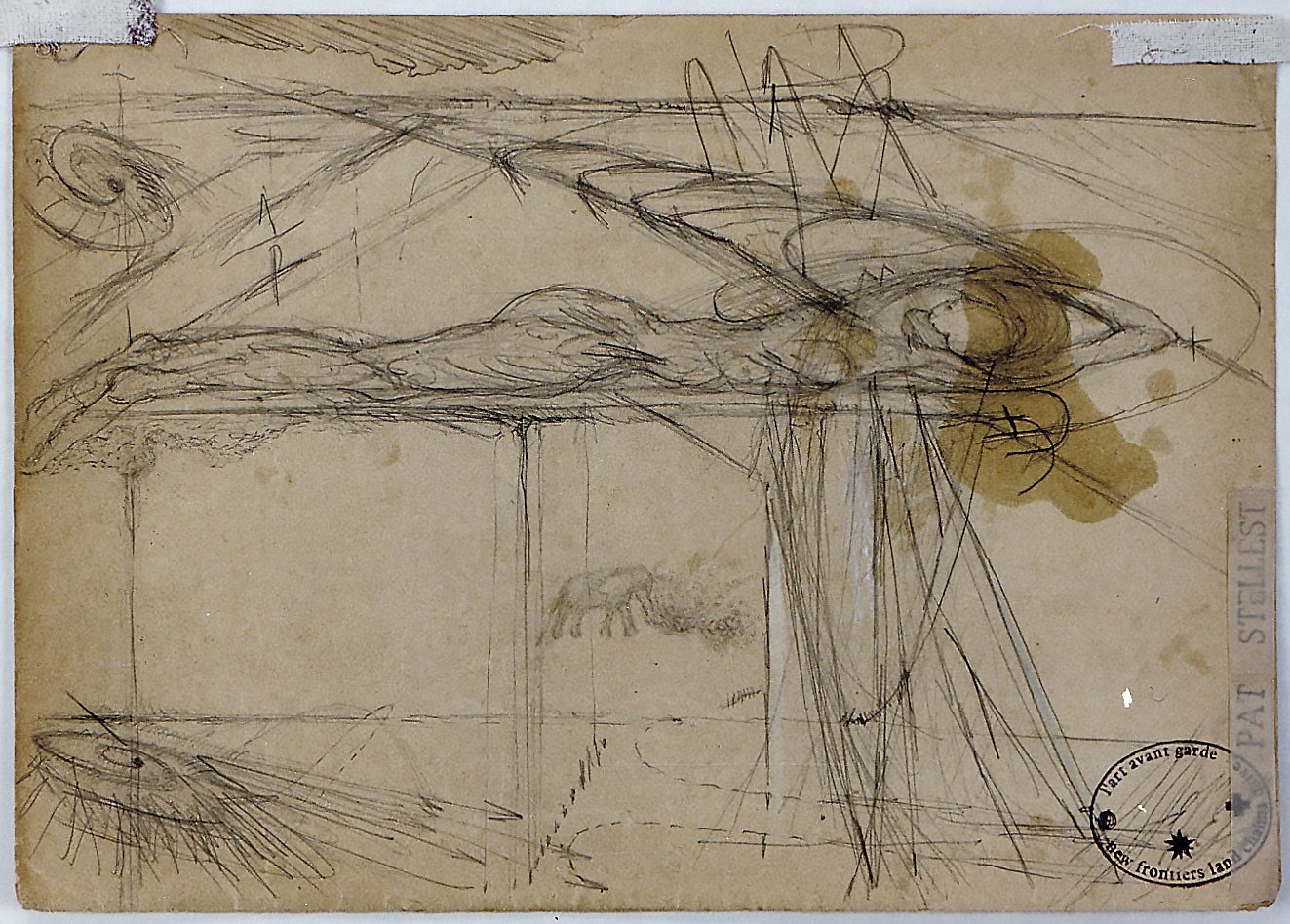
Basquiat Beuys
In Basquiat Beuys: Paris, rue du Théâtre, Patrice Stellest pays tribute to two iconic figures of contemporary art: Jean-Michel Basquiat and Joseph Beuys. This intriguing work, which blends drawing and collage, explores the influences and interactions between these two emblematic artists while capturing the essence of their respective contributions to the art world.
The painting features two stylized faces, possibly those of Basquiat and Beuys, rendered with dynamic and expressive lines. These faces, almost spectral, seem to float in an abstract space, surrounded by geometric shapes and varied textures. The features of the characters, marked by strong intensity, suggest the complexity and depth of their artistic personalities. The eyes, particularly captivating, reveal a wealth of emotion, oscillating between reflection and creative energy.
The background is composed of earthy tones and rectangular shapes, perhaps in homage to Beuys’s raw materials and conceptual approach. This visual simplicity contrasts with the tormented lines and rich textures of the faces, recalling the energy and iconographic diversity of Basquiat’s works. The characters’ hair, depicted by intertwined and chaotic lines, adds a dimension of controlled disorder, reminiscent of Basquiat’s distinctive style and his exploration of the boundary between order and chaos.
Elements of collage, integrated into the composition, enrich the texture of the work and underscore Stellest’s experimental approach. These collages bring additional depth and visual complexity, reinforcing the dialogue between the styles and ideas of the two artists represented.
The color palette is deliberately limited, using mainly shades of brown, black, and white, with discreet touches of yellow. This chromatic sobriety emphasizes the forms and lines, allowing a focus on the expression and symbolism of the characters.
Basquiat Beuys: Paris, rue du Théâtre is thus a poetic exploration of the cross-influences of two major artists, where each visual element contributes to a deep reflection on art, identity, and culture. Stellest creates a space where the worlds of Basquiat and Beuys meet, offering the viewer a contemplative experience rich in meanings.
The painting features two stylized faces, possibly those of Basquiat and Beuys, rendered with dynamic and expressive lines. These faces, almost spectral, seem to float in an abstract space, surrounded by geometric shapes and varied textures. The features of the characters, marked by strong intensity, suggest the complexity and depth of their artistic personalities. The eyes, particularly captivating, reveal a wealth of emotion, oscillating between reflection and creative energy.
The background is composed of earthy tones and rectangular shapes, perhaps in homage to Beuys’s raw materials and conceptual approach. This visual simplicity contrasts with the tormented lines and rich textures of the faces, recalling the energy and iconographic diversity of Basquiat’s works. The characters’ hair, depicted by intertwined and chaotic lines, adds a dimension of controlled disorder, reminiscent of Basquiat’s distinctive style and his exploration of the boundary between order and chaos.
Elements of collage, integrated into the composition, enrich the texture of the work and underscore Stellest’s experimental approach. These collages bring additional depth and visual complexity, reinforcing the dialogue between the styles and ideas of the two artists represented.
The color palette is deliberately limited, using mainly shades of brown, black, and white, with discreet touches of yellow. This chromatic sobriety emphasizes the forms and lines, allowing a focus on the expression and symbolism of the characters.
Basquiat Beuys: Paris, rue du Théâtre is thus a poetic exploration of the cross-influences of two major artists, where each visual element contributes to a deep reflection on art, identity, and culture. Stellest creates a space where the worlds of Basquiat and Beuys meet, offering the viewer a contemplative experience rich in meanings.
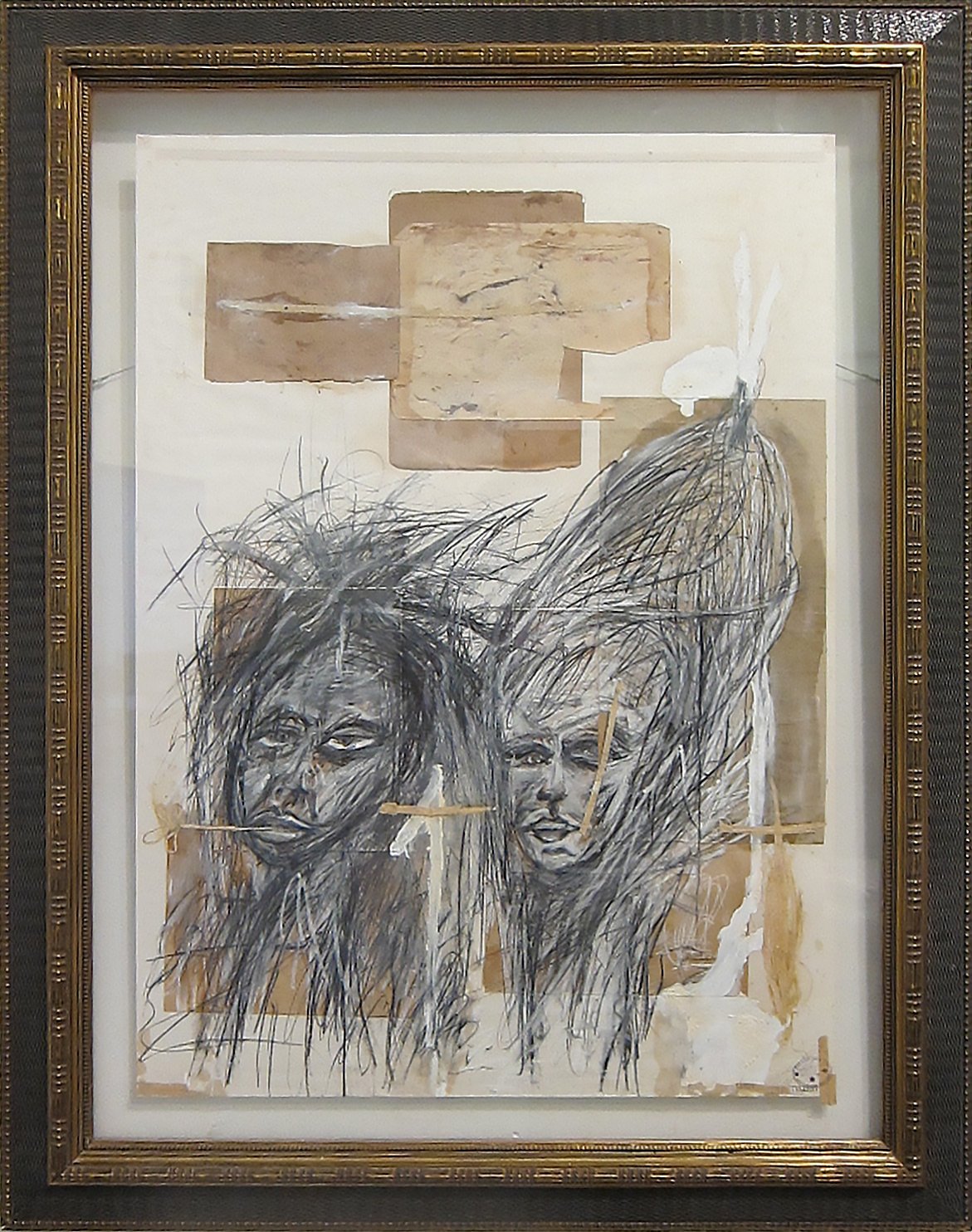
The Red and the Black
Patrice Stellest’s work The Red and the Black, while distinguished by its unique visual language, can subtly be linked to Stendhal’s famous novel of the same name. The Red and the Black is an exploration of the ambitions, passions, and inner struggles of a young man facing a rigid and stratified society. This duality between red, a symbol of passion and action, and black, representing restraint, asceticism, and religious life, is symbolically reflected in Stellest’s work.
The first thing that strikes the observer is the use of vivid red, a color that immediately draws the eye and seems to embody vitality and passion. The human figure, rendered in a minimalist yet expressive style, floats in space, giving the impression of either falling or flying—a duality that reflects the ambiguity of the work’s title. This red, which could symbolize life, energy, or even danger, contrasts sharply with the more neutral background, creating a dramatic effect that invites reflection on the nature of the action depicted.
The human figure, with stretched and deformed limbs, recalls surrealist works where reality dissolves into the imaginary. It is both anchored in a physical world and transcendent, as if navigating between two dimensions. This duality is reinforced by the presence of a spiral in the background, a universal symbol of continuity, evolution, and mystery. The spiral, here depicted in shades of red and gray, seems to draw the figure in, absorbing it in a whirlwind of energy, perhaps suggesting an inner journey, a quest for identity, or a confrontation with the unknown.
The contrast between the figure’s bright red and the more subdued tones of the rest of the composition creates a visual tension that captivates the viewer. This tension can be seen as a metaphor for internal struggles between opposing forces, such as passion and reason, impulse and restraint, the visible and the invisible.
Furthermore, the composition is marked by a delicate juxtaposition of natural and organic elements. The lines emanating from the human figure evoke veins, roots, or antennas, connecting the figure to the rest of the cosmos, as if it were an integral part of a vast network of life. This connection between the individual and the universe, between the microcosm and the macrocosm, is a recurring theme in Stellest’s work, emphasizing a holistic view of existence.
The Red and the Black also explores the notion of transformation. Red, traditionally associated with alchemy, passion, and blood, could here symbolize a form of metamorphosis, a passage from one state to another. The human figure could represent a being in transition, caught between two worlds, oscillating between light and darkness, the material and the spiritual.
In conclusion, this work by Patrice Stellest is a powerful exercise in contrast, not only in its use of red and black but also in the way it addresses themes of existence, movement, and transformation. Red and Black invites the viewer to contemplate the fundamental oppositions of life and to find meaning in the interaction of these forces.
The first thing that strikes the observer is the use of vivid red, a color that immediately draws the eye and seems to embody vitality and passion. The human figure, rendered in a minimalist yet expressive style, floats in space, giving the impression of either falling or flying—a duality that reflects the ambiguity of the work’s title. This red, which could symbolize life, energy, or even danger, contrasts sharply with the more neutral background, creating a dramatic effect that invites reflection on the nature of the action depicted.
The human figure, with stretched and deformed limbs, recalls surrealist works where reality dissolves into the imaginary. It is both anchored in a physical world and transcendent, as if navigating between two dimensions. This duality is reinforced by the presence of a spiral in the background, a universal symbol of continuity, evolution, and mystery. The spiral, here depicted in shades of red and gray, seems to draw the figure in, absorbing it in a whirlwind of energy, perhaps suggesting an inner journey, a quest for identity, or a confrontation with the unknown.
The contrast between the figure’s bright red and the more subdued tones of the rest of the composition creates a visual tension that captivates the viewer. This tension can be seen as a metaphor for internal struggles between opposing forces, such as passion and reason, impulse and restraint, the visible and the invisible.
Furthermore, the composition is marked by a delicate juxtaposition of natural and organic elements. The lines emanating from the human figure evoke veins, roots, or antennas, connecting the figure to the rest of the cosmos, as if it were an integral part of a vast network of life. This connection between the individual and the universe, between the microcosm and the macrocosm, is a recurring theme in Stellest’s work, emphasizing a holistic view of existence.
The Red and the Black also explores the notion of transformation. Red, traditionally associated with alchemy, passion, and blood, could here symbolize a form of metamorphosis, a passage from one state to another. The human figure could represent a being in transition, caught between two worlds, oscillating between light and darkness, the material and the spiritual.
In conclusion, this work by Patrice Stellest is a powerful exercise in contrast, not only in its use of red and black but also in the way it addresses themes of existence, movement, and transformation. Red and Black invites the viewer to contemplate the fundamental oppositions of life and to find meaning in the interaction of these forces.
